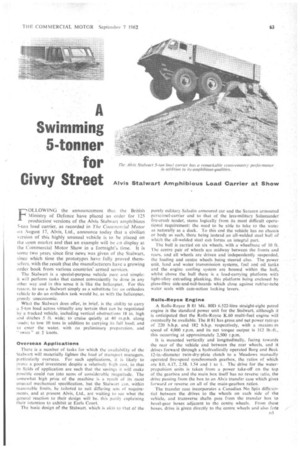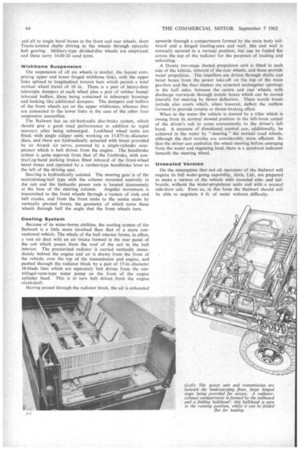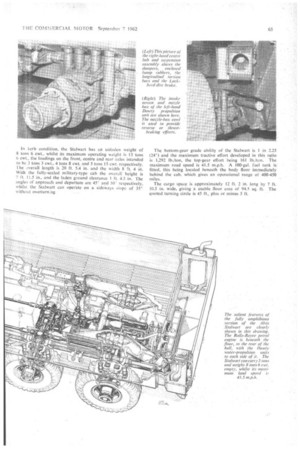A Swimming 5-tonner for Civvy Street
Page 65

Page 66

Page 67

If you've noticed an error in this article please click here to report it so we can fix it.
Alvis Stalwart Amphibious Load Carrier at Show FOLLOVVING the announcement that the British Ministry of Defence have placed an order for 125 production" versiOns of the Alvis Stalwart amphibious 5-ton load carrier, as recorded in The Commercial Motor on August 17, Alvis, Ltd., announce today that a civilian version of this highly unusual vehicle is to be placed on the open market and that an example will be on display. at the Commercial Motor Show in a fortnight's time. It is some two years since first news was given of the Stalwart, since Which time the prototypes. have fully proved themselves, with the result that the manufacturers have a growing order book from various countries' armed services.
The Stalwart is a special-purpose vehicle pure and simple: it will perform tasks that cannot conveniently be done in any other way and in this sense it is like the helicopter. For this reason, to use a Stalwart simply as a substitute for an orthodox vehicle to do an orthodox task would be. as with the helicopter.
grossly uneconomic. .
What the Stalwart does offer, in brief, is the ability to carry a 5-ton load across virtually, any terrain that can be negotiated by a tracked vehicle, including vertical obstructions 18 in. high and ditches 5 ft. wide; to cruise quietly at 40 m.p.h. along roads; to tow 10 tons in addition to carrying its full load; and to enter the water, with no preliminary preparation, and swim" at 5 knots.
Overseas Applications
There is a number of tasks for which the availability of the Stalwart will materially lighten the load of transport managers, particularly overseas. For such applications, it is likely to prove a good investment despite a relatively high cost, in that its fields of application are such that the savings it will make possible could run into sums of considerable magnitude. The somewhat high price of the machine is a result of its most unusual mechanical specification, but the Stalwart can, -within reasonable limits, be tailored to suit differing sets of requirements, and at present Alvis, Ltd., are waiting to see what the general 'reaction to their design will be. this party explaining iheir intention to exhibit at Earls Court.
The basic design of the Stalwart, which is akin to that of the purely military Saladin armoured car and the Saracen armoured personnel-carrier and to that of the less-military Salamander fire-crash tender, stems logically from its most difficult operational requirement: the need to be able to take to the water as naturally as a duck. To this end the vehicle has no chassis or body as such, there being instead an all-welded steel hull of which the all-welded steel cab forms an integral part.
The hull is carried on six wheels, with a wheelbase of 10 ft. The centre pair of wheels are midway between the fronts and rears, and all wheels are driven and independently suspended, the leading and centre wheels being steered also. The power unit, land and water transmission systems, fuel and oil tanks and the engine cooling system are housed within the hull, whilst above the hull there is a load-carrying platform with light-alloy extruding planking, this platform being enclosed by glass-fibre side-and-tail-boards which close against rubber-tube water seals with cam-action locking levers.
Rolls-Royce Engine
A Rolls-Royce B 81 Mk. 80D 6.522-litre straight-eight petrol engine is the standard power unit for the Stalwart, although it is anticipated that the Rolls-Royce K.60 multi-fuel engine will eventually be available. The B 81 has gross and net power ratings of 220 b.h.p. and 182 b.h.p. respectively, with a maximt m speed of 4,000 r.p.m. and its net torque output is 312 lb.-ft., this occurring at approximately 2,500 r.p.m.
It is mounted vertically and longitudinally, facing towards the rear of the vehicle and between the rear wheels, and it drives forward through a hydraulically operated Borg and Beck 12-in.-diameter twin-dry-plate clutch to a Meadows manually operated five-speed synchromesh gearbox, the ratios of which are 8.0, 4.17, 2.58, 1.54 and 1 to 1. The drive for the waterpropulsion units is taken from a power take-off on the top of the gearbox and the main box itself has no reverse ratio, the drive passing from the box to an Alvis transfer case which gives forward or reverse on all of the main-gearbox ratios.
The transfer case incorporates a Canadian No Spin differential between the drives to the wheels on each side of the vehicle, and transverse shafts pass from the transfer box to bevel-gear boxes adjacent to the centre wheels. From these boxes, drive is given directly to the centre wheels and also fore and aft to single bevel boxes at the front and rear wheels, short Tracta-jointed shafts driving to the wheels through epicyclic hub gearing. Military-type divided-disc wheels are employed, and these carry 14.00-20 sand tyres.
Wishbone Suspension
The suspension of all six wheels is similar, the layout comprising upper and lower forged wishbone links, with the upper links splined to longitudinal torsion bars which permit a total vertical wheel travel of 10 in, There is a pair of heavy-duty telescopic dampers at each wheel plus a pair of rubber bump/ rebound buffers, these being contained in telescopic housings and looking like additional dampers. The dampers and buffers of the front wheels act on the upper wishbones, whereas they are connected to the lower links in the case of the other four suspension assemblies.
The Stalwart has an air-hydraulic disc-brake system, which should give a good road performance in addition to rapid recovery after being submerged. Lockheed wheel units are fitted, with single caliper units working on 15.875-in.-diameter discs, and these are hydraulically actuated with boost provided by an Airpak air servo, powered by a single-cylinder compressor which is belt driven from the engine. The handbrake system is quite separate from that of the footbrake, with contract:ng-band parking brakes fitted inboard of the front-wheel beve3 boxes and operated by a ratchet-type handbrake lever to the left of the driving seat.
Steering is hydraulically assisted. The steering gear is of the recirculating-ball type with the column mounted centrally in the cab and the hydraulic power ram is located transversely at the base of the steering column. Angular movement. is transmitted to the front wheels through a 'system of rods and bell cranks, and from the front stubs to the centre stubs by vertically pivoted levers, the geometry of which turns these wheels through half the angle that the front wheels turn.
Cooling System
Because of its water-borne abilities, the cooling system of the Stalwart is a little more involved than that of a more conventional vehicle. The whole of the hull interior forms, in effect, a vast air duct with an air intake formed in the rear panel of the cab which passes from the roof of the cab to the hull interior. The pressurized radiator is carried vertically immediately behind the engine and air is drawn from the front of the vehicle, over the top of the transmission and engine, and pushed through the radiator block by a pair of 17-in.-diametcr 10-blade fans which are separately belt driven from the centrifugal-vane-type water pump on the front of the engine cylinder head. This is in turn belt driven from the engine crankshaft.
Having passed through the radiator block, the air is exhausted upwards through a compartment formed by the main body tailboard and a hinged loading-area end wall: this end wall is normally secured in a vertical position, but can be folded flat across the top of the radiator for the purposes of loading and unloading.
A Dowty two-stage ducted propulsion unit is fitted in each side of the vehicle, inboard of the rear wheels, and these provide water propulsion. The impellers are driven through shafts and bevel boxes from the power take-off on the top of the main gearbox and the duct intakes are screened rectangular openings in the hull sides, between the centre and rear wheels, with discharge rearwards through nozzle boxes which can be moved laterally for steering by thrust deflection. These nozzle boxes include also cowls which, when lowered, deflect the outflow forward to provide reverse or thrust-braking effect.
When in the water the vehicle is steered by a tiller which is swung from its normal stowed position in the left-front corner of the driver's cab to come conveniently to the driver's left hand. A measure of directional control can, additionally, be achieved in the water by " steering " the normal road wheels, although the duct nozzles are considerably more efficient. So that the driver can centralize the wheel steering before emerging from the water and regaining land, there is a quadrant indicator beneath the steering wheel.
Unsealed Version
On the assumption that not all operators of the Stalwart will require its full water-going capability, Alvis, Ltd., are prepared to make a version of the vehicle with unsealed sideand tailboards, without the water-propulsion units and with a normal side-door cab. Even so, in this form the Stalwart should still be able to negotiate 4 ft. of water without difficulty.
in kerb condition, the Stalwart has an unladen weight of 8 tons 6 cwt., whilst its maximum operating weight is 13 tons 6 cwt.. the loadings on the front, centre and rear axles intended to be 3 tons 3 cwt., 4 tons 8 cwt. and 5 tons 15 cwt. respectively. The overall length is 20 ft. 5.4 in. and the width 8 ft. 4 in. With the fully-sealed military-type cab the overall height is
7 ft. 11.5 in., and the laden ground clearance 1 ft. 4.5 in The angles of approach and departure are 45° and 50' respectively, whilst the Stalwart can operate on a sideWays slope of 35' without overturn:ng
The bottom-gear grade ability of the Stalwart is 1 in 2.25 (24') and the maximum tractive effort developed in this ratio is 1,292 lb./ton, the top-gear effort being 161 lb./ton. The maximum road speed is 41.5 m.p.h. A 100-gal. fuel tank is fitted, this being located beneath the body floor immediately behind the cab, which gives an operational range of 400-450 miles.
The cargo space is approximately 12 ft. 2 in. long by 7 ft. 10.5 in. wide, giving a usable floor area of 94.5 sq. ft. The quoted turning circle is 45 ft., plus or minus 5 ft.








































































































































